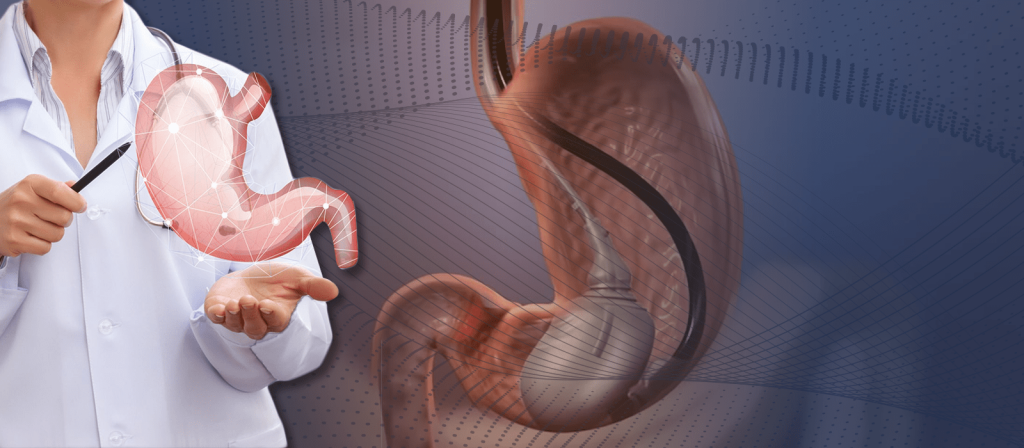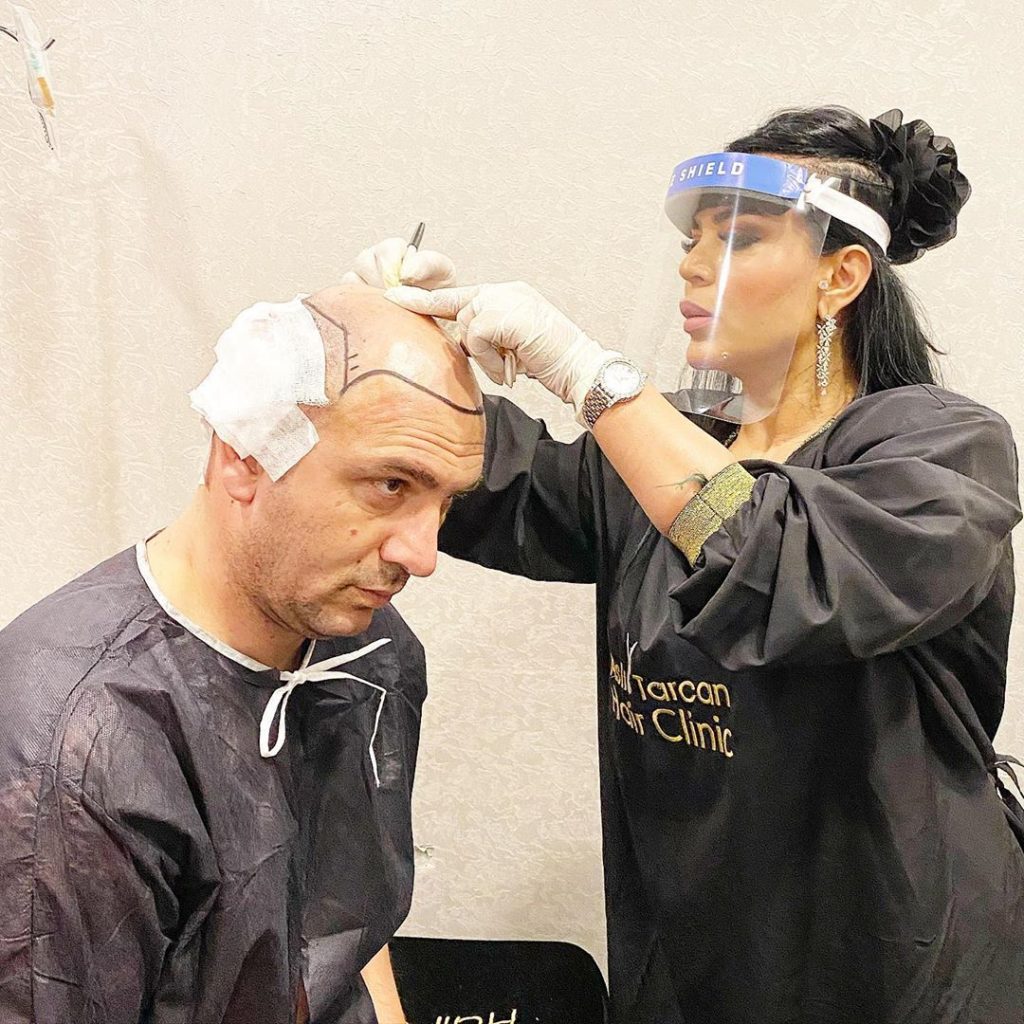
Intragastric balloon, also called gastric balloon, is commonly used to help people lose weight by enabling them to change their eating habits and life styles. With the gastric balloon placed in the patient’s stomach, the patient experiences fullness for a longer time with smaller portions of food. In the long term, the gastric balloon highly reduces your food consumption and helps you lose weight in a healthy gradual way.
How Is The Gastric Balloon Replaced?
The gastric balloon is placed into the patient’s stomach endoscopically. The balloon system includes a soft and expandable balloon, a filling tube and a filling system. Before everything else, the surgeon performs a diagnostic endoscopy in order to make sure that the patient does not have any medical condition that may hinder the placement of the gastric balloon such as ulcer. If the surgeon decides that there is no such condition, a deflated balloon made of silicone elastomer based material is placed into the patient’s stomach. The balloon is inserted through the mouth, down the esophagus and into the patient’s stomach with a thin and flexible tube called endoscope, which has a light and a camera on one end. In order to prevent any discomfort during this process, the surgeons usually numb the throat area by using a throat spray.
After the gastric balloon is placed into the patient’s stomach, the surgeon will remove the catheter pulling gently on the external end. Finally, the gastric balloon is filled with a blue liquid using the filling tube attached to it and the balloon starts floating in the patient’s stomach.
This procedure takes about 20 to 25 minutes and is usually performed under mild sedative or light anesthesia to ensure comfort to the patient. Patients are discharged after a two hour observation period.
The gastric balloon which is placed in the patient’s stomach provides the patient a sense of a stomach that is half full; therefore, it reduces the amount of food that is taken into the body and prevents over eating. In order to achieve maximum results, patients are provided with a healthy diet and exercise program during this period. It is important that patients keep these habits also after the Intragastric balloon is removed. The balloon is removed after 6 or 12 months after the placement. The six month period one is called “Allergan Gastric Balloon” and the 12 month period one called “Spatz Gastric Balloon”. Since acidic fluids in the patient’s stomach will weaken the material of the Intragastric balloon and cause it to deflate, longer periods of the balloon are not usually recommended. Should the surgeon decide that the patient needs to use the balloon longer, it is highly important that the balloon is replaced with a new one.
There is also a third type called “Elipse Intragastric Balloon” with a 4 month period, which is relatively a new method. The main difference of this balloon is that it does not require anesthesia for insertion or a procedure for removal since it detaches itself from the body after the 4 month period. This balloon consists of a capsule which is attached to a thin filling tube. The patient is to swallow the capsule with a glass of water, then the surgeon checks whether or not the capsule is in the patient’s stomach. If it is, the balloon is filled with fluid and the filling tube is gently removed. After the 4 month period the balloon dissolves and passes natural ways.


During the period that the gastric balloon is in the patient’s stomach, the surgeon may prescribe the patient some oral medication to reduce the stomach acid, this way the risk of a stomach irritation and damage to the balloon is reduced.
Advantages Of The Gastric Balloon
The placement of the gastric balloon is minimally invasive, it does not require surgery and it is an outpatient procedure. It is also preferable in that it does not change the anatomy of the patient’s stomach. This gastric balloon program makes it really easy for the patients to achieve a healthier body and life style in a safe way.
But it is important to remember that the gastric balloon alone does not guarantee a considerable weight loss. It is just there to help patients while they are achieving it. In order to get the wanted results, patients must apply a program of healthy diet and exercise. During this journey, patients will have physicians, dietitians and psychotherapists who will help them trough this period. It is also important for patients to keep these life style changes after the removal of the gastric balloon, so that they do not experience relapses.
The most popular gastric balloon program lasts 12 months, 6 months of which are the therapeutic months with the placed balloon in the stomach. After these months, the gastric balloon is removed and since there is no balloon to make patients feel full and prevent them from over eating this period is very crucial. During this period, the patient must be in touch with a dietitian, physician, psychotherapist and a fitness specialist to make sure that they keep their healthy life style habits stable. This will help the patients to maintain their lower weight and continue losing weight after the gastric balloon is removed.
The gastric balloon helps patients lose around 7 to 15% of their total body weight in the first six months following the placement of the balloon. Total weight loss may vary from 30 to 47%, depending on the diet and exercise program carried out. If the patient does not stick to the life style changes, it is highly possible to regain the weight that is lost. In order to make sure this does not happen, patients must be involved in regular exercise, a healthy diet and frequent follow-ups. They must be in touch with their dietitians and physicians and follow their instructions.
Who Is Considered Suitable For Gastric Balloon Procedure?
People who have a Body Mass Index (BMI) above 27 might be recommended to have a gastric balloon procedure; people who suffer from an illness related with obesity, in particular. However, the patient must be 18 years old or older.
This procedure also might be considered suitable for people who are too overweight to undergo a vital surgery, since weight loss through the gastric balloon procedure will reduce the risks of surgical procedures on these patients.
Long term weight loss will also improve any health problems that are caused by obesity such as diabetes, hypertension, sleep apnea and psychological problems.
What You Can Eat With The Gastric Balloon?
Usually, following the first days after the placement of the gastric balloon, the patient’s diet is based on liquids, purees and some soft foods only. In order to let the body grow comfortable with the gastric balloon and avoid any discomfort, the transition to solid food happens slowly and gradually. After a 2 week period it is okay to move on to consuming solid food. As mentioned before, it is very important for patients to follow their dietitian’s instructions, eat healthy and exercise. This will be easier due to the gastric balloon in their stomach, which will reduce their appetite considerably. Knowing that the balloon will help control their eating habits, patients should also keep in mind that it is important not to rely too much on the gastric balloon and that they still have to work hard.
What To Do After The Gastric Balloon Surgery?
How soon you will be able to return to your daily activities depend on how fast your body will adapt to the gastric balloon. However, it is best that you plan at least 3 days off from your normal activities. It is usually suggested that the patient takes a week off work after the insertion of the balloon in order to make sure that their body has adapted to the balloon. During this period, heavy exercises must definitely be avoided. After the body has adapted, it is encouraged to start exercising gradually week by week to help you lose weight. However, you will not have anything to worry about, since your consultants will be there to form a program for you during the whole process.
The gastric balloon is then removed the same way it is inserted: trough the mouth via an endoscope. This procedure is usually carried out under general anesthesia and lasts 20 minutes.
What Are The Possible Risks With Gastric Balloon?
Following the 2 or 3 days after the gastric balloon placement patients may experience nausea, vomiting or cramps. Usually, the doctors provide patients with the right medication to use in such situations before they leave the hospital. These kinds of symptoms usually go away after 2 or 3 days. Still, should you feel any discomfort or unusual pain, consult to your doctors without wasting any time.
Even though it is a simple procedure that does not require surgery, there still might be some risks of the gastric balloon you must be aware of. For example, due to the gastric balloon in your stomach, you might have difficulty in consuming enough liquids, leading to dehydration. You might also experience severe nausea, vomiting and cramps in the stomach. These are normal for the first few days after the gastric balloon placement and will disappear shortly; after your body is adapted to the balloon. You will also be given the necessary medication to help prevent or improve the situation.
Due to the gastric balloon which irritates the lining of the patient’s stomach, patients may experience ulcers. Doctors usually provide the patients with omeprazole or other proton pump inhibitors, so that the stomach acid is reduced while the balloon is in there. This way the risk of damage to the gastric balloon is reduced, too. It is also important that the patients do not take nonsteroidal anti-inflammatory drugs, NSADIDs in short, such as ibuprofen or naproxen.
Although it is a low risk, the balloon might deflate and move through the patient’s digestive system and cause a blockage. This can be highly hazardous and you must take action immediately. This situation will be easy to notice, since it will change your urine color to greenish or blue. The reason of this is that the balloon is filled with a colored dye called methylene blue. These deflated gastric balloons might need to be removed endoscopically. In other cases, it is likely that it will leave your body naturally through your digestive system.
As some other rare situations, the patient might need an early removal of the gastric balloon because of intolerance or some patients who have a history of stomach surgery might have the risk of gastric perforation.
In What Conditions You Must Be Hesitant To Go Through The Procedure?
Even if your Body Mass Index is suitable for the Intragastric balloon procedure, there might be some contraindications that will hold you back from going through it. For example, if you are pregnant or breastfeeding, if you have history of blood-thinning medications or you are currently using them, if you have serious liver damage, if you have history of stomach or bariatric surgery, if you have anomalies in the gastrointestinal tract it is not recommended that you have Intragastric balloon procedure.
There are some other alternatives to Intragastric balloons such as sleeve gastrectomy trough which your digestive tract is shortened; gastric bypass which involves by-passing the patient’s stomach and part of the intestinal tract; or gastric banding to create a small pouch at the top of the patient’s stomach to limit the food intake.
The main difference of the Intragastric balloon is that it does not require staying at the hospital and has fewer complications, shorter recovery time and a lower risk of serious complications, unlike the ones mentioned above, which are all major surgical procedures.
All in all, the Intragastric balloon procedure is a go to, especially if diet and exercise did not work on you before, since it is a safe, simple procedure that does not require surgery and helps you to adjust a healthier and easier life style.


